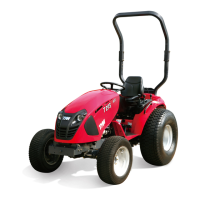ROPS (ROLL OVER PROTECTIVE STRUCTURE)
ROLL OVER PROTECTIVE STRUCTURES (ROPS)
.,
minimize the possibility of serious operator injury result from accidental upset. These are called as
ROPS and are characterized by providing space for the clearance zone inside the envelope of the
structure or within a space bounded by a series of straight lines from the outer edge of the tractor to
any part of the Tractor that might come in contact with flat ground and is capable of supporting the
Tractor in that position if the Tractor overturns.
The mounting structure and fasteners forming the mounting connection with the Tractor are part of
the ROPS.
Loosen and release the knob slowly and cautiously to fold down the ROPS.
If Tractor is operated with ROPS folded (E.g. to enter a low building) Drive with
extreme caution and do not use seat belt. Fold the ROPS up again before the
Tractor is operated under normal conditions.
Please note that in no condition. The tractor is to be operated without ROPS.
O ti th t t ith t ROPS ith f ld d
pera
ng
e
rac
or w
ou
, w
o
e
ROPS with damaged ROPS or hardware can lead to fatal injuries
ROPS MAINTENANCE AND INSPECTION
The ROPS has been certified to industry and/or government standards. Any damage or alteration to
the ROPS, mounting hardware or seat belt voids the certification and will reduce or eliminate
protection for the operator, in the event of a roll-over.
The ROPS, mounting hardware and seat belt should be checked after the first 100 hrs. of machine
operation and every 500 hrs thereafter for any evidence of damage wear or cracks. In the event of
d lt ti th ROPS t b l d i t f th ti f th hi Th t
amage or a
era
on
e
mus
e rep
ace
pr
or
o
ur
er opera
on o
e mac
ne.
e sea
belt must be worn during machine operation when it is equipped with a certified ROPS. Failure to
do so will reduce or eliminate protection of the operate in the event of a roll-over. Substitution of
mounting hardware, seat belt etc. with components not equal to or superior to the original certified
components will void the certification and will reduce or eliminate protection for the operator in the
event of a roll-over.
27

